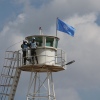
Smoke rises from the site of an Israeli airstrike that targeted an area on the outskirts of the eastern Lebanese city of Baalbek, in the Bekaa Valley, on Thursday.
Nidal Solh/AFP via Getty Images
hide caption
toggle caption
Nidal Solh/AFP via Getty Images
BEIRUT — As Israel intensified attacks in the eastern Lebanese city of Baalbek this week, residents with nowhere else to go fled to the ancient Roman temples, hoping the archaeological site’s internationally protected status might save them.
The governor of Baalbek-Hermel province, Bachir Khodr, told them even that was no longer safe.
“Some citizens went to the Baalbek citadel,” he told NPR, referring to the part of the ancient site where the 2,000-year-old temple of Jupiter and temple of Bacchus are located. “But their lives are also at risk there, so to protect them, their safety and their lives, I urged them to leave the entire city of Baalbek.”

Debris lies on the street after an Israeli airstrike hit the eastern Lebanese village of Al-Kayal, near Baalbek, on Thursday, amid the ongoing war between Israel and Hezbollah.
Sam Skaineh/AFP via Getty Images
hide caption
toggle caption
Sam Skaineh/AFP via Getty Images
The Israeli military Wednesday released a map on social media encompassing the entire city and surrounding villages, warning it was preparing to bomb the area in its fight against the militant group Hezbollah. Tens of thousands of residents fled the city after the warning.
The Lebanese Health Ministry said Israeli airstrikes in Baalbek killed 19 people Wednesday, including eight women. It said at least 60 people, including children, were killed earlier in the week in Israeli attacks in the surrounding Bekaa Valley.
The Bekaa, nestled between mountain ranges east of Beirut, is home to Shia and Sunni Muslims as well as Christians and Druze. An agricultural area near the Syrian border, it is also a strong base of support for Iran-backed Hezbollah, which has been fighting Israel across the Lebanese-Israeli border since the Gaza war erupted a year ago.

People inspect the damage at the site of an Israeli airstrike in Al-Kayal, Lebanon, Thursday.
Sam Skaineh/AFP via Getty Images
hide caption
toggle caption
Sam Skaineh/AFP via Getty Images
Israel last month escalated its attacks in Lebanon, sending invading ground forces across the border in south Lebanon, broadening airstrikes to northern Lebanon and central Beirut and assassinating Hezbollah leader Hassan Nasrallah in September.
Israel said Wednesday it targeted Hezbollah command and control centers and fuel depots in the Bekaa Valley. Live coverage from Lebanese television networks captured explosions and huge plumes of black smoke after Lebanon’s state news agency said airstrikes hit diesel tanks in the town of Douris.
The region is one of the poorest in Lebanon. Despite the danger, many residents have stayed because they have no place to go. In late September on a Hezbollah press tour of the Bekaa, hospitals were filled with civilian casualties of Israeli airstrikes. At one site, a food warehouse, local residents had swarmed the destroyed site to try to recover bags of lentils and beans.

Residents try to evacuate Lebanon’s eastern city of Baalbek on Wednesday after a statement from the Israeli army warning residents of incoming strikes.
Nidal Solh/AFP via Getty Images
hide caption
toggle caption
Nidal Solh/AFP via Getty Images
Khodr, the Baalbek provincial governor, said the government had inspected the ancient site, indicating the purpose was to ensure there were no fighters and no weapons stored there with extra guards posted to avoid infiltration and prevent looting.
He said Israeli airstrikes earlier this week destroyed part of a Roman stone wall at the archaeological site.
Another local official, the head of municipalities in Deir al-Ahmar, northwest of Baalbek, told NPR on Thursday that many people had panicked in a rush to get to safety. He said families were fleeing in several directions, including toward Arsal, near the Syrian border.
“There is a very large displacement movement. Even the shelters are being evacuated,” the local official Jean Fakhry told NPR by phone.
“Yesterday the situation got a lot worse,” Fakhry said. He said more than 20,000 newly displaced people fled to Deir al-Ahmar, about 13 miles from Baalbek, on Wednesday. He said emergency services distributed blankets, food and water to the displaced, many who were sleeping in vehicles.
“We cannot absorb this many people — we are asking the Lebanese government for help,” he said.

Smoke rises from the site of an Israeli airstrike that targeted Lebanon’s eastern city of Baalbek, in the Bekaa Valley, on Wednesday.
Nidal Solh/AFP via Getty Images
hide caption
toggle caption
Nidal Solh/AFP via Getty Images
Baalbek has been inhabited for roughly 11,000 years. The Roman-ruled Phonecian city dates back to more than 2,000 years and is inscribed on UNESCO’s list of World Heritage Sites.
Before the war, it was one of Lebanon’s most visited tourist sites — the soaring Roman temples and a major Shia shrine evidence of the sweep of civilizations over millennia. The name Baalbek itself derives from the storm god Baal, worshiped 3,000 years ago, before Christianity swept the Roman Empire and later Islam took root.
Many Shias believe a daughter of Imam Hussein — Sayidah Khawla — is buried in the gold-domed shrine after dying there following her capture at the seventh century battle of Karbala. Imam Hussein, a grandson of the Prophet Muhammad, was killed in Karbala — a defining event in Shia history.
Wassim el Naghi, an adviser to Lebanon’s culture minister, said the most recent airstrikes had hit about half a mile from the excavated archaeological site but the ministry would have to determine the effect of shocks on the structures.
“It is like an earthquake,” he told NPR. “We cannot assess yet but such heavy bombardment usually has an impact on the above-ground and underground archaeological remains.”
(Except for the headline, this story has not been edited by PostX News and is published from a syndicated feed.)




